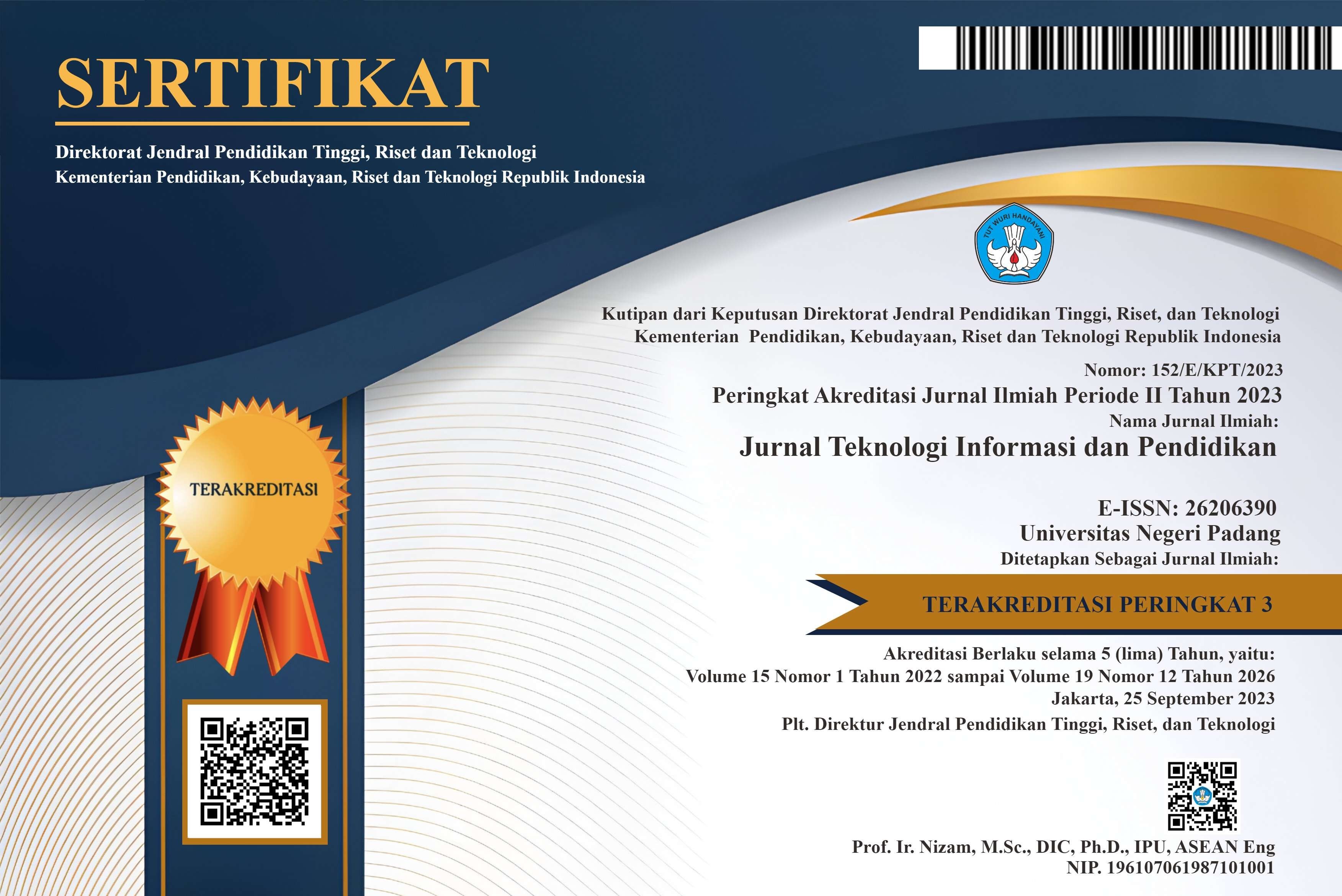Evaluation of Student Ability in Laboratory of Electronics Engineering Department with Fuzzy Logic Calculation
Abstract
Instructive frameworks normally utilize old-style strategies for execution assessment. In this framework, understudy execution relies upon Quiz outcomes and is assessed uniquely as progress or disappointment. Elective, non-traditional execution assessment strategies might be utilized, like fuzzy rationale, a numerical procedure of set-hypothesis that can be applied to many types of dynamic remembering research for designing and man-made brainpower. This review proposes another presentation assessment technique dependent on fuzzy rationale frameworks. Understudy execution of Control Technique Laboratory in University State of Padang Technical Education Faculty, electronics engineering Department, was done with fuzzy rationale and it was contrasted and old-style assessing strategy. Study Quizs are notes in which twenty understudies took the control procedure lab course. Assessment of the outcomes showed varieties among the traditional and fuzzy rationale techniques. In spite of the fact that exhibition assessment utilizing fuzzy rationale is confounded and requires extra programming, it gives some assessment benefits. fuzzy rationale assessment is adaptable and gives numerous assessment alternatives, while the old-style strategy holds fast to consistent numerical estimation. At the implementation stage, the instructor liable for the lab implementation can alter the scopes of participation capacities and rules, allowing non-homogenous yet adaptable and target execution assessment.
References
[2] Ç. Semerci, “Paper Abstracts,” J. Am. Geriatr. Soc., vol. 58, no. 2, pp. 1–246, 2010, doi: 10.1111/j.1532-5415.2010.02850.x.
[3] D. Dubois, H. Prade, U. P. Sabatier, D. Narbonne, and T. Cedex, “Misunderstandings , bridges and gaps,” Recherche, no. 3.
[4] J. F. Baldwin, “Using a Fuzzy Logic,” Fuzzy Sets Syst., vol. 2, pp. 309–325, 1979.
[5] A. Barlybayev, A. Sharipbay, G. Ulyukova, T. Sabyrov, and B. Kuzenbayev, “Student’s Performance Evaluation by Fuzzy Logic,” Procedia Comput. Sci., vol. 102, no. August, pp. 98–105, 2016, doi: 10.1016/j.procs.2016.09.375.
[6] K. Mittal, A. Jain, K. S. Vaisla, O. Castillo, and J. Kacprzyk, “A comprehensive review on type 2 fuzzy logic applications: Past, present and future,” Eng. Appl. Artif. Intell., vol. 95, no. August, p. 103916, 2020, doi: 10.1016/j.engappai.2020.103916.
[7] A. E. B. Abu-Elanien, M. M. A. Salama, and M. Ibrahim, “Calculation of a health index for oil-immersed transformers rated under 69 kV using fuzzy logic,” IEEE Trans. Power Deliv., vol. 27, no. 4, pp. 2029–2036, 2012, doi: 10.1109/TPWRD.2012.2205165.
[8] M. Idrees et al., “Fuzzy Logic Based Calculation and Analysis of Health Index for Power Transformer Installed in Grid Stations,” RAEE 2019 - Int. Symp. Recent Adv. Electr. Eng., vol. 4, pp. 1–6, 2019, doi: 10.1109/RAEE.2019.8887016.
[9] T. C. Entringer, A. da S. Ferreira, M. V. Souza, and D. C. de O. Nascimento, “Reference Models for Production Planning and Control Systems: A Bibliometric Analysis and Future Perspectives,” Int. J. Adv. Eng. Res. Sci., vol. 5, no. 8, pp. 324–331, 2018, doi: 10.22161/ijaers.5.8.40.
[10] T. J. Ross, FUZZY LOGIC WITH ENGINEERING Second Edition. 2004.
[11] A. Maseleno, M. Muslihudin, and T. Susi Susanti, “The priority of rural road development using fuzzy logic based simple additive weighting,” Int. J. Pure Appl. Math., vol. 118, no. January, pp. 9–16, 2018, [Online]. Available: https://www.researchgate.net/publication/323277673.
[12] M. C. Jones and W. W. L. Cheung, “Using fuzzy logic to determine the vulnerability of marine species to climate change,” Glob. Chang. Biol., vol. 24, no. 2, pp. e719–e731, 2018, doi: 10.1111/gcb.13869.
[13] B. Al-Madani, F. Orujov, R. Maskeliūnas, R. Damaševičius, and A. Venčkauskas, “Fuzzy logic type-2 based wireless indoor localization system for navigation of visually impaired people in buildings,” Sensors (Switzerland), vol. 19, no. 9, 2019, doi: 10.3390/s19092114.
[14] H. Ahmadi, M. Gholamzadeh, L. Shahmoradi, M. Nilashi, and P. Rashvand, “Diseases diagnosis using fuzzy logic methods: A systematic and meta-analysis review,” Comput. Methods Programs Biomed., vol. 161, pp. 145–172, 2018, doi: 10.1016/j.cmpb.2018.04.013.
[15] S. Hendiani and M. Bagherpour, “Developing an integrated index to assess social sustainability in construction industry using fuzzy logic,” J. Clean. Prod., vol. 230, pp. 647–662, 2019, doi: 10.1016/j.jclepro.2019.05.055.
Copyright (c) 2022 Jurnal Teknologi Informasi dan Pendidikan

This work is licensed under a Creative Commons Attribution-ShareAlike 4.0 International License.















.png)














